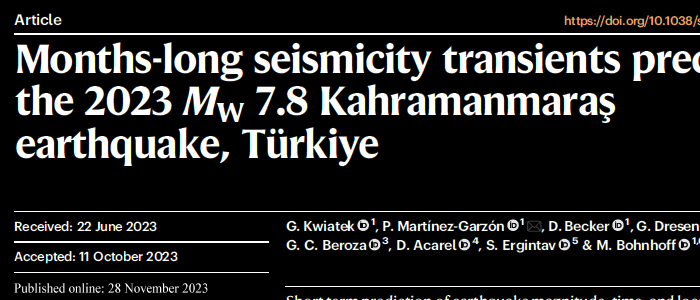On February 6th, 2023, the devastating Mw 7.8 Kahramanmaraş earthquake in South East Türkiye ruptured multiple fault segments of the East Anatolian Fault Zone. This earthquake and its aftershock sequence was followed by a second large earthquake with MW 7.6 about 9 hours later and some 90 kilometres away from the epicenter of the first mainshock.
Combined, the ground shaking from these powerful earthquakes led to nearly 60,000 casualties.
We studied seismic processes preceding the Mw 7.8 Kahramanmaraş mainshock. The spatio-temporal analysis of regional seismicity allowed to observe an 8-month long crustal seismicity transient suggesting a preparation process in the region around the epicenter. This highlighted the high and – more importantly – increasing seismic hazard there. The observed spatio-temporal clustering and localization of seismicity is known from controlled laboratory rock deformation experiments and has been observed for some – but by far not all – large continental earthquakes during the last decades.
This earthquake was among the most destructive of this century, and it was also my first time in the field after such disaster. The more time it passes, the more it resonates in me the images of the pain it caused. I wish one day our work can help to mitigate this.
Reference:
Kwiatek, G., P. Martínez-Garzón, D. Becker, G. Dresen, F. Cotton, G. C. Beroza, D. Acarel, S. Ergintav, and M. Bohnhoff (2023). Months-long seismicity transients preceding the 2023 MW 7.8 Kahramanmaraş earthquake, Türkiye. Nature Communications 14, 7534, DOI: 10.1038/s41467-023-42419-8. [ Article Page ] [ Download open-access article ]
